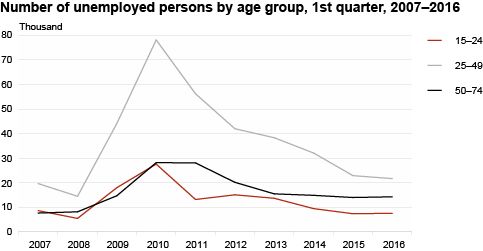Analytics, Employment, Estonia, Labour-market, Markets and Companies
International Internet Magazine. Baltic States news & analytics
Saturday, 27.04.2024, 06:51
The beginning of 2016 didn’t bring any major changes to Estonian labour market
 Print version
Print version
In the 1st quarter of 2016, the unemployment rate increased by 0.1 percentage points compared to the 4th quarter of 2015. The small growth can largely be explained by seasonal effects, since several economic activities require less labour force in the winter. Compared to the 1st quarter of 2015 there were also no major changes in the unemployment rate – the unemployment rate has decreased 0.1 percentage points.
In the 1st quarter of 2016, there were approximately 630,000 employed and 43,600 unemployed persons in the labour market. The labour force participation rate, i.e., the share of the labour force in population aged 15–74 increased by 0.8 percentage points compared to the 1st quarter of the previous year, bringing approximately 6,400 more persons to the labour market.

The employment rate, i.e., the share of the employed in population aged 15–74 was 64.1% in the 1st quarter of 2016. Although compared to the 1st quarter of the previous year the employment rate increased, it remained lower than in the other quarters of 2015.
There are still differences in labour market indicators depending on socio-demographic characteristics. By age groups, the employment rate is the lowest among 15–24-year-olds, which comes largely from unfinished studies. Due to studies, approximately 79,200 young persons were not active in the labour market in the 1st quarter of 2016, representing a majority of 15–24-years old inactive persons. Compared to the 1st quarter of 2015, the employment rate of 15–24-year-olds decreased by 1.4 percentage points, in other age groups employment indicators improved. The employment rate of 50–74-year-olds was 54.3% in the 1st quarter, having increased by about 1.8 percentage points compared to the 1st quarter of 2015.
In the 1st quarter of 2016, the employment rate of Estonians was 5.1% and that of non-Estonians was 9.8%. Compared to the 1st quarter of the previous year, the unemployment rate among Estonians has decreased by 0.7 percentage points, at the same time the number increased by 1.2 percentage points among non-Estonians. The unemployment rate of non-Estonian men decreased by 0.6 percentage points, at the same time among non-Estonian women it increased by 3.1 percentage points. Compared to the 1st quarter of 2015, among Estonian men the unemployment rate decreased by 0.1 percentage points while it decreased by 1.4 percentage points among Estonian women.
In 1st quarter of 2016, the employment gap between men and women aged 15–74, i.e., the difference between the respective employment rates was 6.5 percentage points. Among 20–64- year-olds, i.e., in the group in the main employment age, the employment gap was 5.9 percentage points. In both age groups the employment gap has decreased compared to the 1st quarter of the previous year.
The unemployment rate is the share of the unemployed in the labour force (the sum of employed and unemployed persons). The employment rate is the share of the employed in the working-age population (aged 15–74). The labour force participation rate shows the share of the labour force in the population aged 15–74. The estimates are based on the data of the Labour Force Survey.
Statistics Estonia has been conducting the Labour Force Survey since 1995 and every quarter 5,000 persons participate in the survey. The Labour Force Survey is carried out by statistical organisations in all the European Union Member States on the basis of a harmonised methodology.








 «The Baltic Course» Is Sold and Stays in Business!
«The Baltic Course» Is Sold and Stays in Business!

